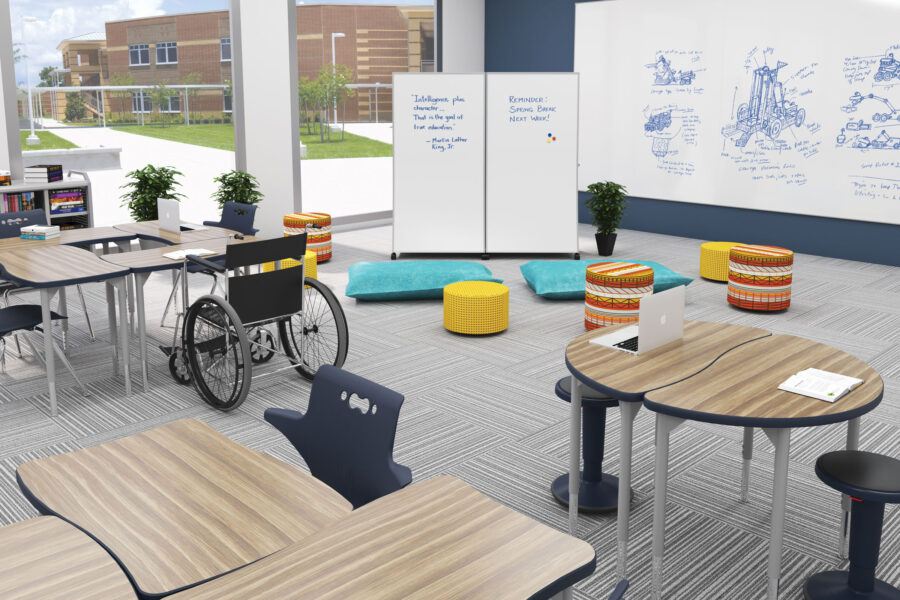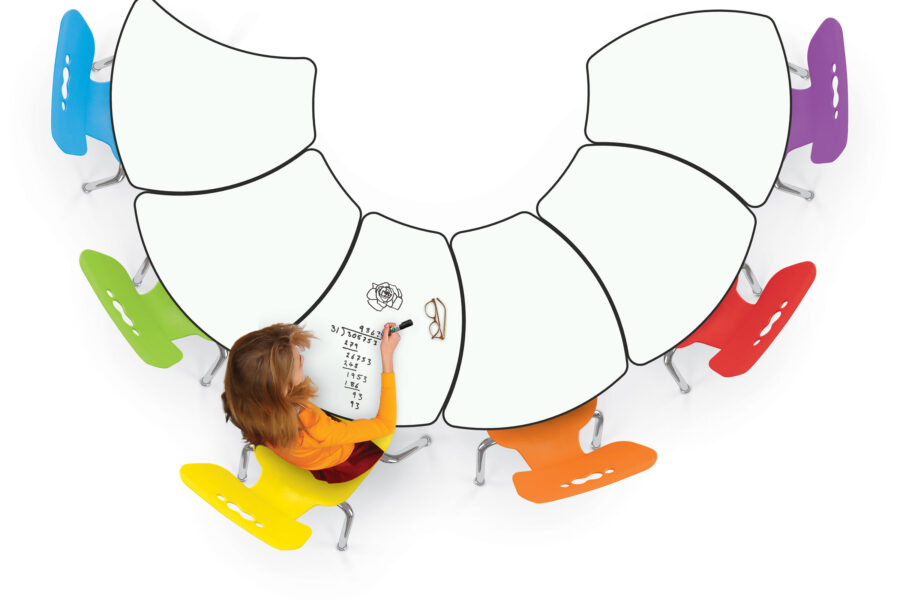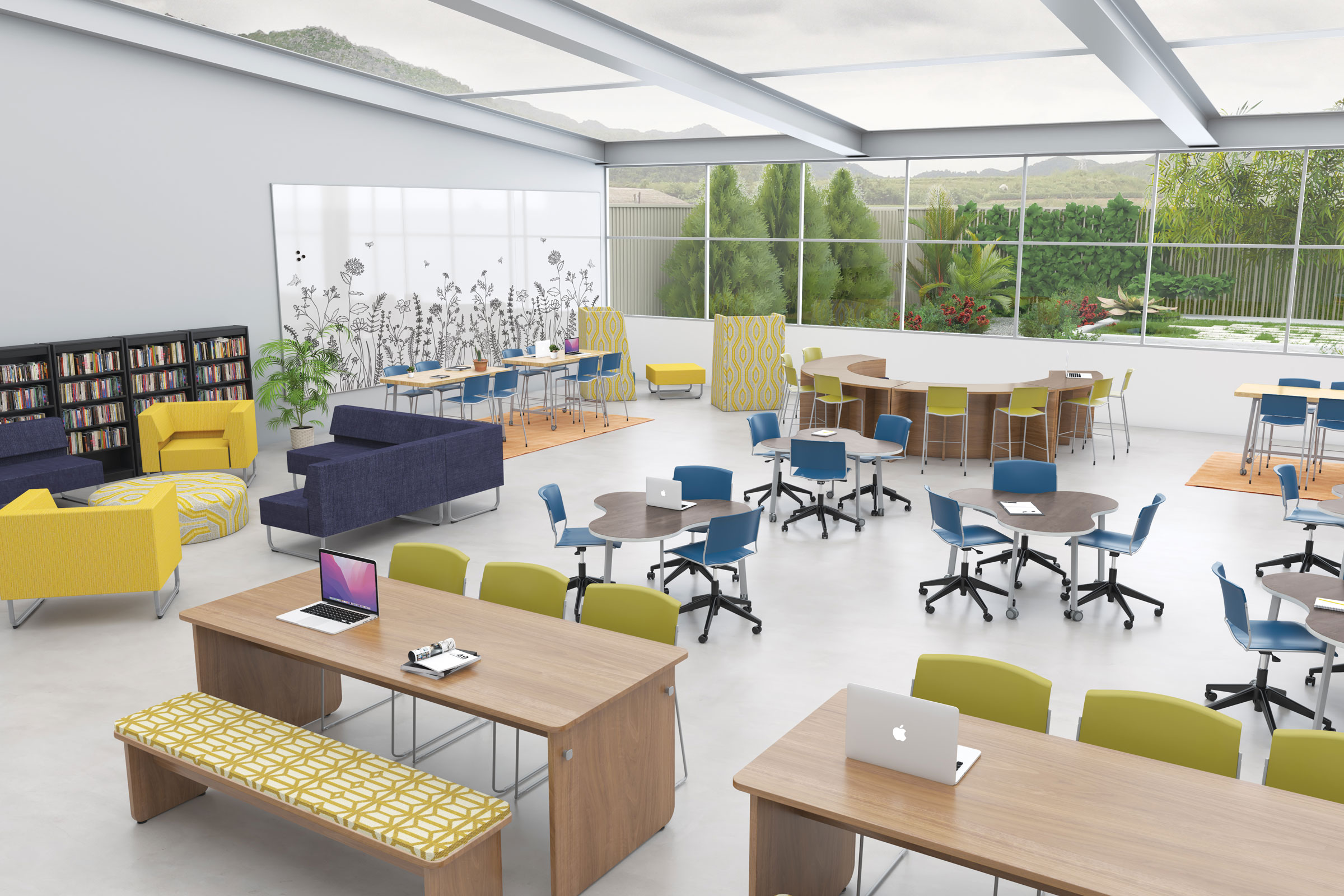Story at a glance:
- As student needs evolve, the spaces where they learn must offer more flexibility.
- MooreCo, a leader in innovative furniture solutions, provides options that make for sensory aware environments.
For decades students sat in rows of desks lined up in front of their teachers. Open concept designs promoted direct instruction, but that uniformity did not keep all students engaged.
Today’s students face new challenges every day—from evolving technology to feeling comfortable in the classroom. Modern learning spaces are breaking out of the four walls of the traditional classroom to allow for greater student exploration, self-discovery, and wellness.
“The best way to address students’ needs is by involving their voices in every project,” says Paola Moore, vice president of marketing for MooreCo, a leader in innovative furniture solutions. “Being aware of the students not only as elements that will occupy the building during a few hours a day, but rather as human beings who are developing their identity and formation, with ambitions and struggles, who are affected by so many things that occur outside the building yet they carry with them every day when they walk through those doors—that’s crucial.”
Meeting Students Needs

MooreCo’s Hierarchy Creator Desk system accommodates different abilities and needs with ADA-compliant desks. Design teams can choose from square, triangle, rectangle, and half-round shapes. Rendering courtesy of MooreCo
To thrive in the 21st century, students need more than traditional academic learning, Rutgers psychology professor Maurice J. Elias said in a 2021 webinar organized by MooreCo. They must be adept at collaboration, communication, and problem-solving, which are some of the skills developed through social and emotional learning, he said, citing an earlier World Economic Forum report on education.
Coupled with mastery of traditional skills, social and emotional proficiency will equip students to succeed in the swiftly evolving digital economy, Elias wrote.
Supporting the social and emotional wellness of students has long been part of global architecture and design firm DLR Group’s mission in designing schools. “A lot of time school is that safe space,” says Ian Kilpatrick, principal K-12 education design leader for DLR Group. “It’s where students are getting fed. It’s where they feel safe because their home environment may not be.”
Fifty years from now classroom design will undoubtedly look different, and already some of those changes are being seen, with more collaborative spaces and various types of seating and tables in the same classroom. Kilpatrick anticipates more shared spaces in the future. “Kind of a suite of spaces where you might have a maker lab or a technology lab,” he says. “Instead of designing five of the same space and furnishing them all the same, designing spaces to facilitate different activities.”
More Options

The Hierarchy Shapes Desk is seen here in a six-pod confirmation with rainbow chairs. Photo courtesy of MooreCo
Manufacturer MooreCo’s innovative furniture designs are driven by a philosophy they call Thrive, which explores how the conscious design of environments can impact human happiness and health.
MooreCo aims to foster environments that inspire and support growth as part of Thrive’s six stages of development—social-emotional, intellectual, moral, psychological, physical, and spiritual. Students develop important life skills like collaboration, communication, and problem-solving through social and emotional learning, for example. “We understand not all students learn the same way,” Moore says. “We identify those needs—physical and social-emotional—and develop products for students to be able to engage and learn in an inclusive way.”
The company considers students’ wide-ranging needs when developing new products, with the aim of helping them engage and learn in more inclusive ways. Their designs are also flexible.
The best way to address students’ needs is by involving their voices in every project.
MooreCo’s Porcelain Steel Hierarchy Shapes Desk comes with a porcelain steel dry-erase top students can use in a variety of ways. This easy-to-assemble desk is designed to last longer than alternatives, while the porcelain steel whiteboard offers space for drawing, note-taking, or brainstorming. It also fosters group work and collaboration—key components to the modern classroom. “In general a markerboard desk is a good idea for students to use in classes,” says Molly Cox, design team manager for MooreCo. “Having one that lasts longer than a few months is much nicer.”
Cox says the adjustable desk is superior to laminate whiteboard desks from both a durability perspective and a use perspective. It also has less glare and is low maintenance. “A lot of times with the laminate you’ll see it’s scratched easily and markerboard particles will get down in there,” Cox says. “That’s not going to happen. With the porcelain steel top, when it erases, it erases. You don’t have to worry about still seeing the lettering on the desk afterward.”
MooreCo’s options vary to meet the needs of users of all ages and activities. Moore knows some students learn better standing, while others learn better sitting; allowing those students to work together with the same product is key. That kind of flexibility is emphasized throughout MooreCo designs. Products can double as tables or mobile whiteboard easels, depending on classroom needs. “Being able to take one piece of furniture and use it in multiple ways without taking up three different spaces to do that in a classroom is cool but also really important to the students and teachers trying to use that space,” Cox says.
Designed to Thrive

“We can outfit an entire facility because we’ll have everything that environment needs,” says MooreCo’s Paola Moore. Rendering courtesy of MooreCo
The Thrive philosophy centers on addressing the various styles of teaching and learning. This includes project-based, experiential leaning, differentiation, online/hybrid, and collaborative/active teaching styles. Learning styles encompass visual, aural/musical, physical, verbal/linguistic/social, color learners, and natural/nature learners. These styles all add up to an increasing need for flexible design.
Much of MooreCo’s recent research has centered on how Gen Z learns, for example, and the impact of Covid-19. According to a MooreCo CEU presentation in 2023, the average student lost more than half a school year of learning in math and nearly a quarter of a school year due to Covid.
The company is also working to share the results of other research—such as how auditory/linguistic learners benefit from collaborative setups, while naturalists connect more with outdoor environments. Solitary learners need quiet spaces, while verbal learners thrive with writing desks or surfaces. Colorful spaces create more engagement, while flexible furniture promotes movement.
Architects at DLR Group agree flexible learning environments are key to successful learning spaces. “Having that choice—soft seating, high-top desks, tables. All of that mixed in a classroom environment gives the autonomy to learn where you learn best or engage the best,” Kilpatrick says. “At the end of the day we’ll see 12 to 15 different pieces of furniture in a lot of our classroom environments, and that helps a lot.”
Flexible seating means offering several options in height, motion, and texture, too. Some students engage with rhythmic motion, like rocking chairs (see the Hierarchy Rocker Chair from MooreCo) or wobble stools (Grow Stool). Other students need to relax their entire body to engage. The Elevate Wind Quartile Chair can be configured in multiple arrangements, while the Akt 5-Star Chair was designed with a beveled edge to help posture. All of MooreCo’s products consider the people who will use the furniture, Moore says.
“It’s not just the ergonomics behind the product or how it supports the back, or how a beveled angle of the chair will support leg circulation,” she says. “It’s also the physical aspect that stimulates your mind.”

